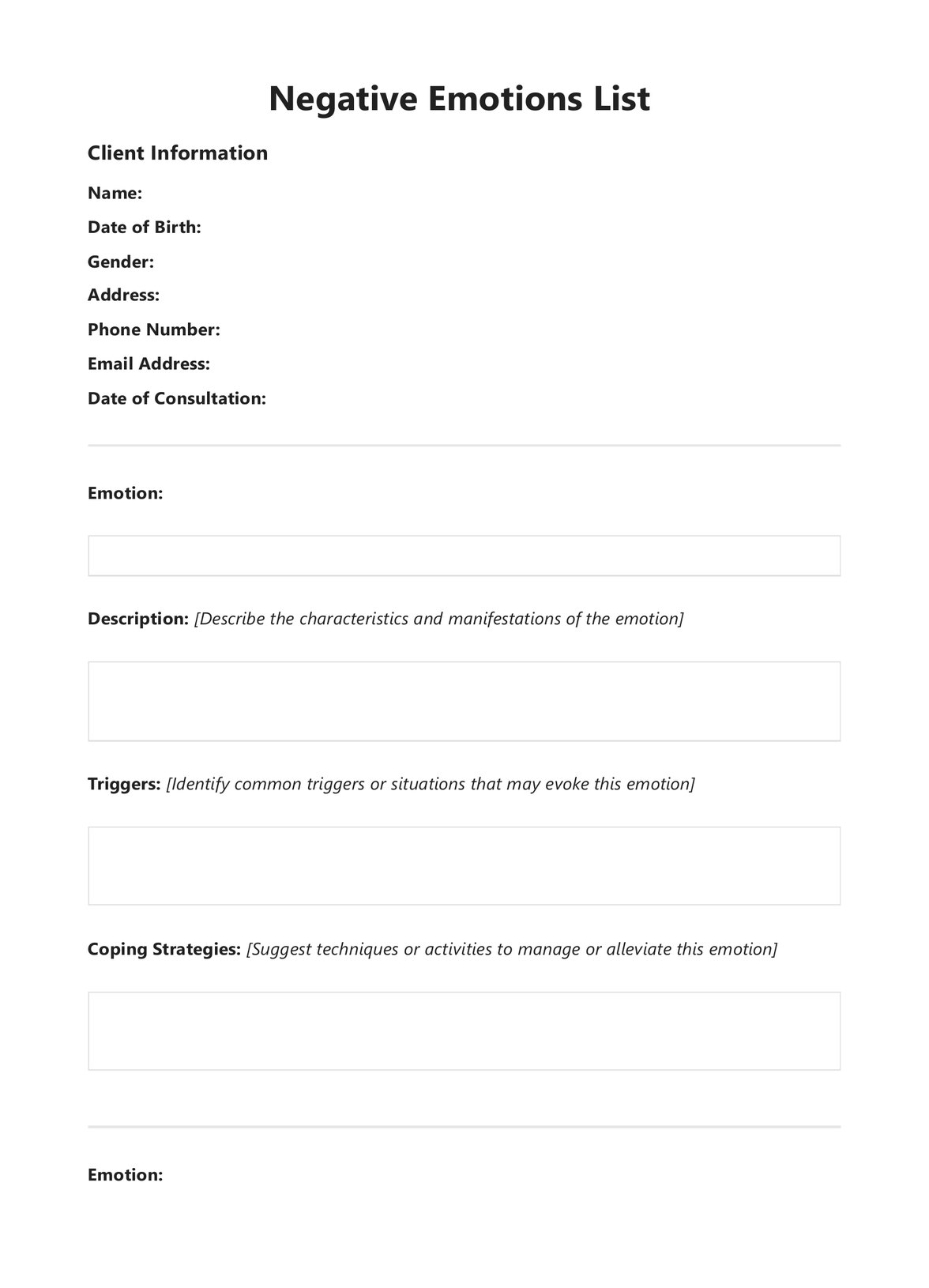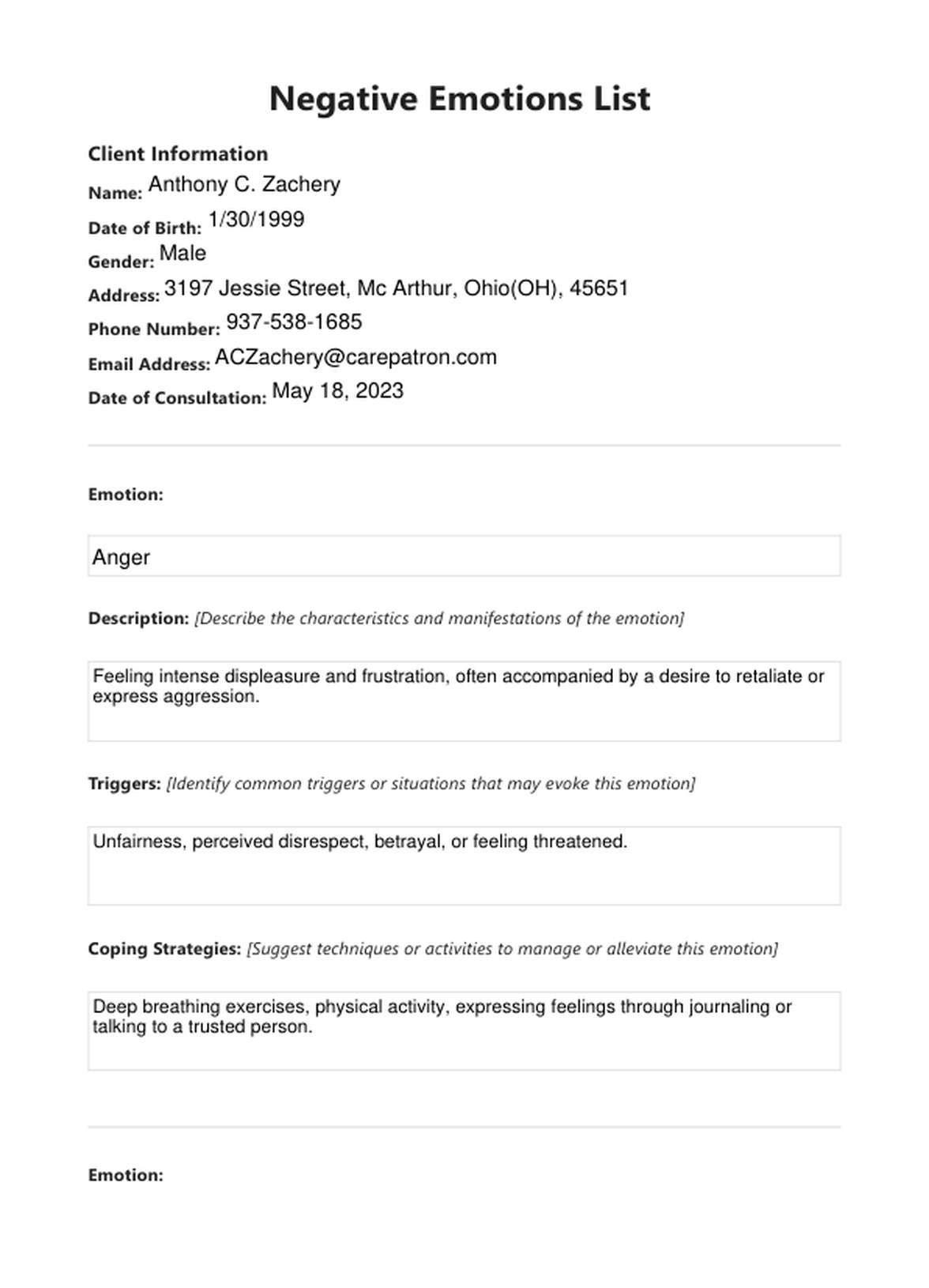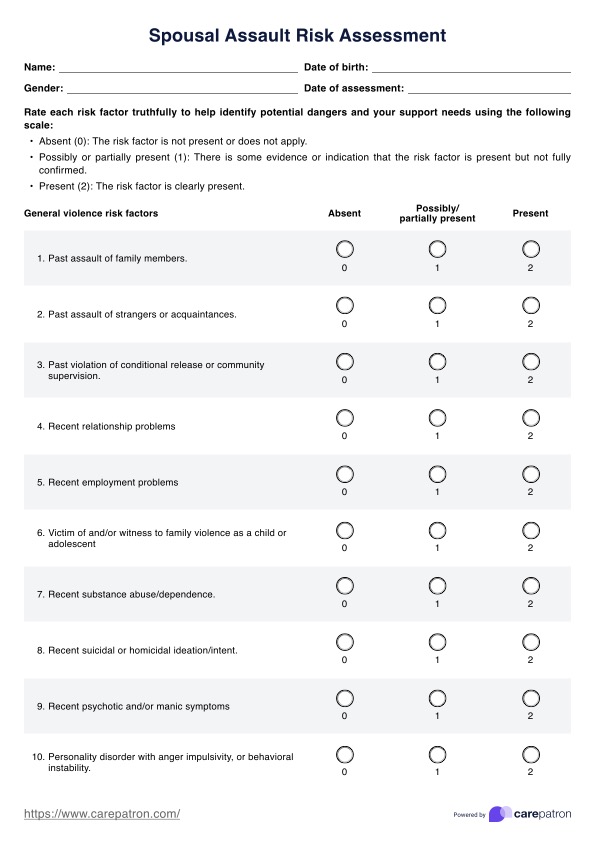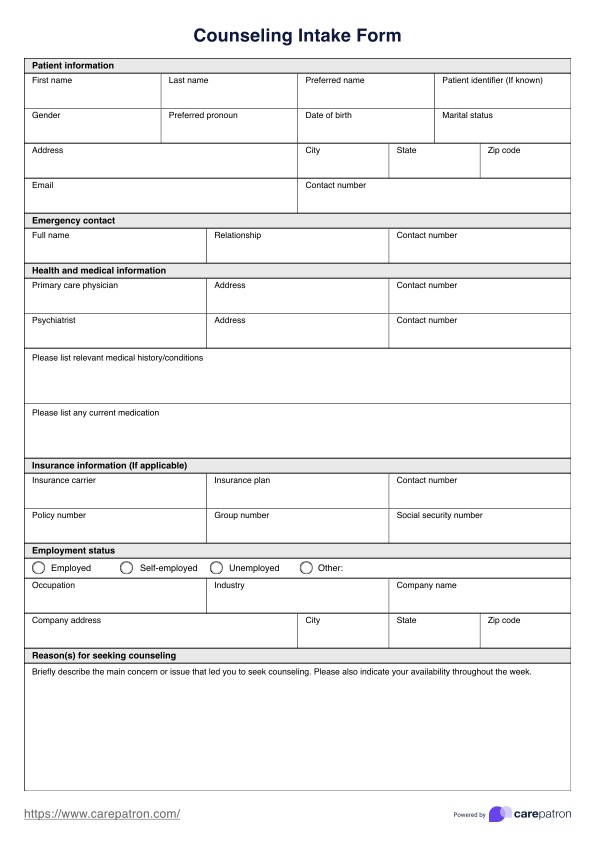Negative Emotions List
Negative emotions are normal in life. Learn about the most common negative emotions, how to cope, and when to seek professional help.


What is a Negative Emotions List?
A Negative Emotions List is a comprehensive compilation of various negative emotions individuals may experience in different situations. It is a valuable resource for understanding, identifying, and acknowledging the wide range of negative emotions that can arise within us.
Negative emotions are an inherent part of the human experience. Events, circumstances, relationships, or internal thoughts and beliefs can trigger them. Common negative emotions include anger, sadness, fear, guilt, shame, jealousy, and loneliness, among many others. However, negative emotions can manifest in countless nuanced ways, making it challenging for individuals to recognize and articulate their feelings.
A Negative Emotions List is a reference guide providing a catalog of these emotions and their descriptions. It enables individuals to pinpoint and label their emotions more accurately, a crucial step towards managing and processing them effectively. By acknowledging and understanding negative emotions, individuals can begin to develop strategies to cope with them, improve their emotional well-being, and foster healthier relationships.
The list can be organized alphabetically or categorically, making it easier for individuals to navigate and find the specific emotions they are experiencing. Each emotion is typically accompanied by a brief description that captures its essence and typical triggers. Some lists may also provide additional information on each emotion's physical, cognitive, and behavioral responses.
A Negative Emotions List is helpful for individuals seeking self-awareness and personal growth and is also valuable for therapists, counselors, coaches, and educators. It can be used as a tool for guiding discussions, promoting emotional intelligence, facilitating communication, and assisting in developing coping strategies and interventions.
Ultimately, a Negative Emotions List is a resource that empowers individuals to gain clarity about their emotions, foster emotional well-being, and navigate the complexities of their inner world. It serves as a reminder that negative emotions are every day and valid experiences, and it provides a starting point for individuals to explore their emotions with greater depth and understanding.
Negative Emotions List Template
Negative Emotions List Example
How does it work?
Using a Negative Emotions List typically involves the following steps:
Access the list
Find a reliable resource or website that provides a comprehensive Negative Emotions List. It can be a downloadable PDF, an online article, or a dedicated webpage.
Familiarize yourself
Take some time to review the entire list and read through the different negative emotions and their descriptions. Understand that the list is not exhaustive but covers a wide range of commonly experienced negative emotions.
Identify your emotions
Reflect on your current emotional state and identify which negative emotions resonate with your feelings. Pay attention to the descriptions and triggers associated with each emotion to see if they align with your experiences.
Label your emotions
Once you have identified the emotions that match how you feel, use the list as a reference to label and name those emotions. This labeling process can help you gain clarity and take ownership of your emotional experiences.
Explore the emotions
Dive deeper into the emotions you have identified. Reflect on the possible causes, triggers, or underlying factors contributing to these feelings. This exploration can aid in understanding yourself better and shed light on areas that need attention or resolution.
Seek additional resources
If you find certain emotions particularly challenging or overwhelming, consider seeking additional resources such as books, articles, or professional help to understand and manage those emotions effectively.
Develop coping strategies
Utilize the Negative Emotions List as a starting point to develop personalized coping strategies. The descriptions accompanying each emotion can provide insights into helpful approaches for dealing with specific negative emotions. Experiment with techniques like journaling, deep breathing exercises, talking to a trusted friend, or seeking professional support.
Remember, a Negative Emotions List is a tool to support your emotional well-being. However, it is not a substitute for professional help if you are experiencing intense or prolonged negative emotions. It can facilitate self-awareness, provide validation, and guide you toward seeking assistance to navigate and process your emotions effectively.
When would you use this Template?
This Negative Emotions List template can be helpful in various contexts and for different practitioners. Here are some scenarios where this resource can be precious:
Self-reflection and personal growth
Individuals seeking to enhance their emotional intelligence, self-awareness, and personal development can utilize this template. By exploring the range of negative emotions provided, individuals can better identify and understand their emotional experiences. This understanding can serve as a foundation for self-reflection, introspection, and taking proactive steps toward emotional well-being.
Therapists and counselors
Mental health professionals can incorporate this resource into their therapy sessions. The Negative Emotions List can act as a starting point for clients to identify and articulate their emotions, facilitating more focused and productive discussions. Therapists can also use the list to educate clients about negative emotions, triggers, and possible coping strategies, empowering them to navigate their emotions more effectively.
Educators and school counselors
This template can be helpful in educational settings to support students' emotional well-being. Teachers and school counselors can introduce the Negative Emotions List as a tool for students to develop an emotional vocabulary and express their feelings. It can foster a safe and open environment for discussions around emotions, and educators can guide healthy coping mechanisms and strategies for emotional regulation.
Coaches and mentors
Professionals working in coaching and mentoring roles can utilize this resource to assist clients in understanding and managing their negative emotions. Using the list as a reference, coaches and mentors can help clients identify their emotional patterns, explore triggers, and develop strategies to address specific negative emotions that may hinder their personal or professional growth.
Support groups and workshops
Facilitators of support groups or workshops focused on emotional well-being can incorporate this template into their activities. Participants can use the Negative Emotions List to share and discuss their experiences, fostering a sense of validation and connection within the group. It can also serve as a basis for group discussions on coping mechanisms, resilience, and emotional self-care.
Benefits
Using a Negative Emotions List template offers several benefits for individuals and practitioners alike:
Enhances self-awareness
The template helps individuals accurately identify and label their emotions, promoting a deeper understanding of their inner experiences.
Facilitates effective communication
Individuals can articulate their emotions more precisely using a standardized list, enabling more transparent communication with therapists, counselors, or support groups.
Promotes emotional intelligence
The template encourages individuals to explore a wide range of negative emotions, fostering the development of emotional intelligence and empathy towards oneself and others.
Provides validation and normalization
Seeing their emotions reflected on the list helps individuals recognize that their negative emotions are common and valid, reducing feelings of isolation and self-judgment.
Guides coping strategies
The template often includes descriptions of triggers and associated responses for each emotion, offering insights into potential coping strategies that individuals can experiment with and develop.
Supports therapeutic interventions
Therapists, coaches, and educators can leverage the template to facilitate discussions, guide interventions, and empower clients or students in their emotional journey.
You can leverage the Relaxation Techniques Template to help clients manage stress and promote calmness. The Emotions List Template enhances emotional awareness and communication by helping clients articulate their feelings. Additionally, using the Cognitive Distortions Template allows you to identify and challenge negative thought patterns, fostering healthier thinking habits and improving overall emotional well-being.
Research & Evidence
The history of the resource, research, and evidence supporting its use is long and complex. The first recorded use of a negative emotions list template was in the early 1900s. At that time, the template was used to help people identify and manage their negative emotions. The template was based on the work of Sigmund Freud, who believed that repressed memories and emotions caused negative emotions.
In the 1950s, the negative emotions list template was popularized by the work of Aaron Beck. Beck believed that cognitive distortions or inaccurate thoughts caused negative emotions. He developed a cognitive therapy technique called cognitive restructuring, which uses the negative emotions list template to help people identify and challenge their cognitive distortions.
In the 1980s, the negative emotions list template was further developed by the work of David Burns. Burns developed a self-help book, Feeling Good, using the template to help people identify and manage their negative emotions. Feeling Good has been translated into over 30 languages and has sold over 5 million copies.
The research and evidence that supports using the negative emotions list template are extensive. A meta-analysis of 19 studies found that cognitive therapy, which uses the template, effectively treats depression. Another meta-analysis of 12 studies found that cognitive restructuring, which also uses the template, effectively treats anxiety.
The negative emotions list template is a simple and effective tool to help people identify and manage their negative emotions. It is based on the work of some of the most respected psychologists in the world, and it has been supported by extensive research. If you are struggling with negative emotions, the negative emotions list template may be a helpful tool for you.
References
Beck, A. T. (1976). Cognitive therapy and the emotional disorders. New York: International Universities Press.
Burns, D. D. (1980). Feeling good: The new mood therapy. New York: Avon Books.
Dozois, D. J. A., Dobson, K. S., & Ahn, W. (2004). Meta-analysis of cognitive-behavioral therapy for depression. Journal of Consulting and Clinical Psychology, 72(3), 648–659.
Hollon, S. D., & Beck, A. T. (1994). Cognitive therapy of depression. In P. C. Kendall (Ed.), Advances in cognitive-behavioral therapy (pp. 27–64). New York: Guilford Press.
Berkeley Well-Being Institute. (2023, May 19). Negative emotions. Retrieved from https://www.berkeleywellbeing.com/negative-emotions.html
Johns Hopkins Medicine. (2023, May 19). Recognize and cope with negative emotions. Retrieved from https://www.hopkinsmedicine.org/about/community_health/johns-hopkins-bayview/services/called_to_care/recognize_cope_with_negative_emotions.html
Happier Human. (2023, May 19). List of negative emotions. Retrieved from https://www.happierhuman.com/list-negative-emotions-wa1/
Positive Psychology. (2023, May 19). Positive and negative emotions. Retrieved from https://positivepsychology.com/positive-negative-emotions/
Lead Through Strengths. (2023, May 19). Negative. Retrieved from https://leadthroughstrengths.com/negative/
Commonly asked questions
Using a Negative Emotions List can help you clarify your emotions, promote self-awareness, and provide a starting point for exploring and managing your negative emotional experiences effectively. It can also facilitate communication with therapists, counselors, or support groups, enabling more focused discussions.
A Negative Emotions List can benefit you by enhancing self-awareness, promoting emotional intelligence, validating your experiences, guiding coping strategies, and providing a sense of normalizing your negative emotions. It can be a valuable tool in personal growth, therapy, coaching, and educational settings.
While a Negative Emotions List is not a direct method for regulating emotions, it can facilitate the process. By identifying and understanding your emotions through the list, you can gain insights into triggers, patterns, and potential coping strategies associated with specific emotions, which can support you in developing practical emotional regulation skills.
Negative Emotions Lists aim to cover a wide range of commonly experienced negative emotions but may not include every possible emotion. The lists are meant to be comprehensive and helpful, but emotions can be highly subjective and nuanced, varying from person to person.
While a Negative Emotions List can be a valuable resource, it is not a substitute for therapy or professional help. Suppose you are experiencing intense or prolonged negative emotions that significantly impact your well-being. In that case, seeking support from a qualified mental health professional who can provide personalized guidance and interventions is essential.



















-template.jpg)


























































































